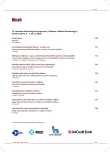New and Older Pharmaceuticals Influencing Insulin Secretion
Authors:
J. Olšovský
Authors‘ workplace:
Diabetologické centrum II. interní kliniky Lékařské fakulty MU a FN u sv. Anny Brno, přednosta prof. MUDr. Miroslav Souček, CSc.
Published in:
Vnitř Lék 2009; 55(4): 421-424
Category:
Overview
The author briefly recapitulates the physiology of insulin secretion and pathophysiology with type II diabetes mellitus. Besides sulfonylurea secretagogues and glinides practically used in the long term, the author points out new possibilities of influencing insulin secretion by way of incretin mimetics and gliptins.
Key words:
diabetes mellitus, type II – insulin secretion – sulfonylurea – glinide – incretin mimetic – gliptin
Sources
1. Butler AE, Janson J, Boner-Weir S et al. Mechanism of reduction of betacell. Diabetes 2003; 52: 102–110.
2. www.diab.cz: Standardy: Laboratorní diagnostika a sledování stavu DM.
3. Perušičová J et al. Perorální antidiabetika. Praha: Galén 2003.
4. Perušičová J. Léčba perorálními antidiabetiky. Postgrad Med 2003; 5: 726–729.
5. Rybka J. Současnost a budoucnost perorálních antidiabetik v léčbě diabetu 2. typu. Vnitř Lék 2001; 47: 285–290.
6. Patel A, MacMahon S, Chalmers J et al. The ADVANCE collaboration Group. Intensive blood glucose control and vascular outcomes in patients with type 2 diabetes. N Engl J Med 2008; 358: 2560–2572.
7. Nathan DM, Buse JB, Davidson MB et al. Management of hyperglycemia in Type 2 diabetes, a consensus algorithm for the initiation and adjustment of therapy. A consensus statement from the American Diabetes Association and the European Association for the Study of Diabetes. Diabetologia 2006; 49: 1711–1721.
8. Olšovský J. Jak používat perorální antidiabetika – algoritmy výběru. Farmakoterapie 2005; 1: 81–85.
9. Holman RR. Assessing the potential for alpha-glucosidase inhibitors in prediabetic states. Diabetes Res Clin Pract 1998; 40 (Suppl 1): S21–S25.
10. Polonsky KS, Given BD, Hirsch LJ et al. Abnormal patterns of insulin secretion in non‑insulin‑dependent diabetes mellitus. New Engl J Med 1988; 318: 1231–1239.
11. Nauck et al. Diabetologia 1986; 29: 46–52
12. Larsson H, Holst JJ, Ahrén B. Glucagon‑like peptide-1 reduces hepatic glucose production indirectly through insulin and glucagon in humans. Acta Physiol Scand 1997; 160: 413–422.
13. Nauck MA, Wollschläger D, Werner J et al. Effects of subcutaneous glucagon‑like peptide 1 (GLP‑1 [7–36 amide]) in patients with NIDDM. Diabetologia 1996; 39: 1546–1553.
14. Drucker DJ. Glucagon‑like peptides. Diabetes 1998; 47: 159–169.
Labels
Diabetology Endocrinology Internal medicineArticle was published in
Internal Medicine

2009 Issue 4
Most read in this issue
- Target Values of Blood Pressure in Patients with Diabetes Mellitus
- Drug Interactions of Selected Drugs Used by Patients with Diabetes Mellitus
- Options of Hormonal Contraceptives and Substitution in Female Diabetic Patients
- Insulin Sensitizing Drugs
